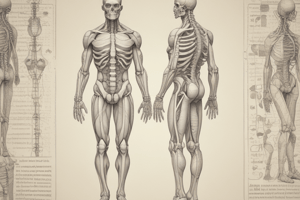Podcast
Questions and Answers
The nose, chin, umbilicus (navel), and spine are examples of ____________ anatomic structures.
The nose, chin, umbilicus (navel), and spine are examples of ____________ anatomic structures.
midline
A 5-year-old boy has fallen and has a severe deformity of the forearm near the wrist. He has possibly sustained a fracture of the:
A 5-year-old boy has fallen and has a severe deformity of the forearm near the wrist. He has possibly sustained a fracture of the:
distal forearm
A fracture of the humerus just above the elbow would be described as a:
A fracture of the humerus just above the elbow would be described as a:
distal humerus fracture
The topographic term used to describe the location of body parts that are closer toward the middle or center of the body is:
The topographic term used to describe the location of body parts that are closer toward the middle or center of the body is:
The topographic term used to describe the part of the body that is nearer to the feet is:
The topographic term used to describe the part of the body that is nearer to the feet is:
In relation to the wrist, the elbow is:
In relation to the wrist, the elbow is:
In relation to the chest, the back is:
In relation to the chest, the back is:
Which of the following anatomic terms is synonymous with the word 'dorsal'?
Which of the following anatomic terms is synonymous with the word 'dorsal'?
A young male jumped from a tree and landed feet first. What aspect of his body has sustained the initial injury?
A young male jumped from a tree and landed feet first. What aspect of his body has sustained the initial injury?
Movement or motion away from the body's midline is called:
Movement or motion away from the body's midline is called:
A patient has fractured both femurs. Anatomically, these injuries would be described as being:
A patient has fractured both femurs. Anatomically, these injuries would be described as being:
Relative to the kidneys, the liver is:
Relative to the kidneys, the liver is:
An intoxicated 40-year-old male is found lying face down. How would you document his body's position?
An intoxicated 40-year-old male is found lying face down. How would you document his body's position?
A patient in a semireclined position with the head elevated to facilitate breathing is in the ________ position:
A patient in a semireclined position with the head elevated to facilitate breathing is in the ________ position:
The axial skeleton is composed of the:
The axial skeleton is composed of the:
The brain connects to the spinal cord through a large opening at the base of the skull called the:
The brain connects to the spinal cord through a large opening at the base of the skull called the:
Which of the following is NOT a facial bone?
Which of the following is NOT a facial bone?
The _______ is made up of the maxilla and zygoma, as well as the frontal bone of the cranium.
The _______ is made up of the maxilla and zygoma, as well as the frontal bone of the cranium.
Flashcards are hidden until you start studying
Study Notes
Anatomical Terms and Body Positioning
- Midline Structures: Examples include the nose, chin, umbilicus, and spine, indicating structures that are located on the body's midline.
- Fracture Locations: A fracture near the wrist in a child indicates a possible distal forearm fracture.
- Fracture Descriptions: A fracture of the humerus just above the elbow is referred to as a distal humerus fracture.
- Medial Definition: The term medial refers to body parts closer to the middle or center of the body.
- Inferior Definition: Inferior describes body parts that are closer to the feet.
Relational Terms
- Proximal and Distal Relationships: The elbow is proximal in relation to the wrist, indicating a closer location to the body's center.
- Posterior Definition: The back is described as posterior in relation to the chest.
- Dorsal Synonym: The term dorsal is synonymous with posterior, both indicating the back side of the body.
Body Orientation and Movement
- Plantar Injuries: An injury sustained by landing feet first relates to the plantar aspect of the body.
- Abduction Motion: Movement away from the body's midline is termed abduction.
- Bilateral Fractures: The term bilateral describes the occurrence of fractures in both femurs, indicating injuries on both sides of the body.
Organ Positioning
- Kidneys and Liver: The liver's positioning is unilateral in relation to the kidneys, indicating it is located on one side.
- Body Positioning: A patient lying face down is in the prone position, while a semireclined position with an elevated head is referred to as Fowler's position.
Skeletal Structure
- Axial Skeleton Composition: The axial skeleton includes the skull, face, thorax, and vertebral column, forming the central part of the skeleton.
- Spinal Cord Connection: The brain connects to the spinal cord through the foramen magnum, a large opening at the base of the skull.
- Facial Bones: The mastoid is not classified as a facial bone; key facial bones include the maxilla, mandible, and zygoma.
Bone Structures
- Orbit Formation: The orbit is formed by the maxilla, zygoma, and the frontal bone, playing a crucial role in housing the eye.
Studying That Suits You
Use AI to generate personalized quizzes and flashcards to suit your learning preferences.




